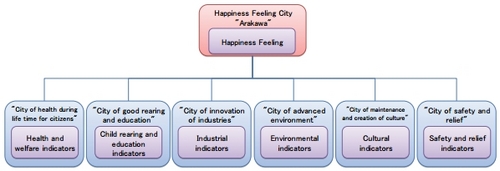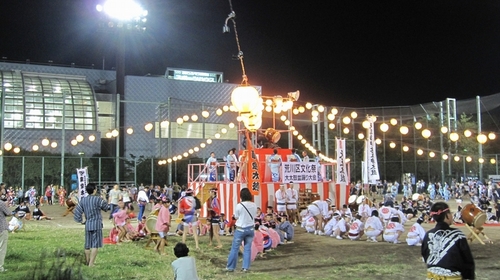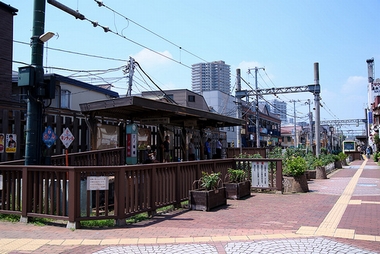September 24, 2013
Arakawa City's 'Gross Arakawa Happiness' (GAH) Initiative Challenges GDP-Centric Thinking, Supports a Sustainable, Happier Community
Keywords: Local government Newsletter Well-Being
JFS Newsletter No.132 (August 2013)
We are constantly offered opportunities in society to rethink the meaning of true well-being and affluence. This is because more people are realizing that the traditional indicator used to show society's progress -- economic growth measured by gross domestic product (GDP) -- is not the only or even most important measurement of its success. To this end, there is an increasing trend both in Japan and around the world to devise indicators to measure people's actual causes and levels of happiness, from the viewpoint of identifying the conditions needed to realize a just, happy, and sustainable society.
JFS launched its "Local Well-Being" project in April 2013, and has since been working to create a framework to formulate meaningful municipal indicators of citizens' happiness and well-being. On June 24, 2013, it held an open seminar featuring the Gross Arakawa Happiness (GAH) set of indicators devised by the city of Arakawa, which is one of the wards of metropolitan Tokyo, for people to learn about an ongoing, pioneering municipal initiative focused on the happiness levels of citizens.
JFS's Newest Challenge: The "Local Well-Being" Project
The city of Arakawa, located in the northeast of Tokyo and endowed with the nature of the Sumida River, is home to a population of about 200,000 people. In 2006, Arakawa started the GAH project to come up with a way to measure the causes and levels of its citizens' happiness over time. In this article, we would like to show how the indicators were introduced and what may lie in the city's future, based on two lectures given at the seminar, one by Kyoichi Futakami, president of the Research Institute of Local Government by Arakawa City (RILAC), and the other by Nanami Nagata, RILAC vice president.
Introduction of GAH Project to Enhance Citizens' Sense of Happiness
RILAC was established in 2009 as a think-tank to research important issues involving the city's policies, and as an independent organization it is unique among basic municipal bodies in Japan. Futakami has been engaged in creating indicators with the city's project team and people in the academic field, and said, "What makes people happy differs from person to person, and it is a difficult issue to determine to what extent a local government can or should intervene in their sense of happiness. However, if the government can get information on what residents feel happy or unhappy about, we can discuss ways to address those issues in the community."
The GAH project was introduced by Arakawa's mayor, Taichiro Nishikawa. When he took office in 2004, he thought that enhancing the happiness of the city's citizens is the ultimate goal to aim for as one of his responsibilities, and he declared that the "city government was really a system to make its citizens happy."
While the mayor was implementing various policies and studying issues affecting the happiness of people in the city, he encountered a book about Bhutan's Gross National Happiness index. The King of Bhutan's idea was that economic development does not necessarily lead to well-being, and that the actual power and progress of a country can be measured by the happiness of its citizens. The mayor was impressed with this idea and decided to advocate studying of the use of GAH, encouraged by the advice of Emeritus Professor Yoshio Tsukio at the University of Tokyo, who said, "Since it is difficult to make every single person happy, it might be better to focus on reducing the number of people who are not feeling happy, even if just by one person at a time."
In 2006, the city included a survey of citizens' happiness in a public poll. The following year it formulated a basic concept and announced the city's targeted future vision: "'Arakawa' -- a city of real happiness."
GAH Indicators and the City's Happiness Survey
The Arakawa Basic Plan included six main visions for the city's future: (1) a city of lifetime health for its citizens, (2) a city of good upbringing and education, (3) a city of innovative industries, (4) a city that is an environmental leader, (5) a city that supports and maintains its arts and culture, and (6) a safe and secure city. The GAH defined indicators corresponding to each of these six aspects.
Arakawa's six future visions : Major indicators
1) A city of lifetime health for its citizens: health and welfare indicators
2) A city of good upbringing and education: upbringing and education indicators
3) A city of innovative industries: industrial indicators
4) A city that is an environmental leader: environmental indicators
5) A cith that supports and maintains its arts and culture: cultural indicators
6) A safe and secure city: safety and security indicators

Indicators corresponding to each of six city images
Source: Second Interim Report of Research Project on Gross Arakawa Happiness (GAH)
For the "Health and Welfare" aspect, physical and mental health, as well as the medical care and welfare environment, are defined as indicators, because happiness is considered to increase when people are healthy. For the "Child Rearing and Education" aspect, family relations -- the extent that a child develops the strengths needed to live in society -- and the environment for child rearing and education, are identified as essential for happiness.
For the "Industry" aspect, indicators are having employment with stable income, a balance between work and life, and a vibrant local economy. For the "Environment" aspect, indicators are convenience, including transport accessibility, comfort, including a beautiful townscape, and having an environmentally friendly lifestyle that saves electricity and reduces waste.
For the "Culture" aspect, indicators are defined in terms of feeling mental happiness through things such as fulfilling and satisfying leisure activities and a sense of attachment to the culture of the city. For the "Safe and Secure" aspect, indicators are the level of anxiety about crime, traffic safety, and disaster preparation.
The city started to study GAH in the opinion survey it started to conduct on an ongoing basis in fiscal 2006 with individuals aged 20 years old and over who live in Arakawa. Up to 1,500 of the samples were randomly selected to be asked more questions, mainly about the five themes of lifestyle, safety and security, connection with the community, motivation in life, and happiness.
In the fiscal 2006 survey on happiness, for the question, "Do you feel happy?" 23.1% of respondents replied "Very much" and 44.9% replied "Relatively," for a combined 68.0%. This combined percentage was 72.6% in fiscal 2007, 76.0% in fiscal 2008, and 73.3% in fiscal 2009, fluctuating at high levels.
As for the question "What is necessary for a happy life?" from around 85% to over 90% of the respondents said "Health," which is the highest every year. The second highest answer is "Relationship with family," from over 50% to over 60%, followed by "Having a place to live" and "Modest affluence." Regarding disasters including earthquakes, the percentage of people who said they feel anxious is increasing.
The survey contents have been improved little by little every year. From fiscal 2008 onwards, the answer sheet includes spaces for free writing, and from fiscal 2009, the survey includes questions about children's happiness.
Promoting Further Use of GAH
Arakawa conducts such surveys on happiness using the GAH indicators, aiming to grasp what residents feel happy about, as well as what they feel unhappy and anxiety about, so that the city can reflect the results in policy improvements and their implications. The city regards it as important to let the citizens know about its efforts and take real action in a move to gain their understanding and participation.
Nagata gave examples of activities to improve GAH levels, including emergency drills, environmental beautification campaigns, and resource recovery by each neighborhood and residents' association, as well as keeping watch on children around elementary schools and nurseries by elderly residents. Also, she described a community cafe where parents with infants and young children gather, which is very popular among parents as they can share their anxiety about raising children and find relief from feelings of isolation with others.
Further efforts to let more residents know about GAH are necessary in the future. As a part of this, a GAH Promotion Leader Committee was established in May 2013. In the committee meetings, experts working in the areas of health and welfare, child rearing and education, industry, environment, culture, and safety and relief exchange their views on GAH activities.
Moreover, an association of municipalities known as the Happiness League, which consists of 52 local governments across the country, was set up in June 2013 with the aim of improving the level of happiness among their citizens. Arakawa is a member of the association, and Mayor Nishikawa was elected as its chairperson. Sharing the same spirit, they aim to build local societies where everybody can feel happier, by learning from each other, and this can be reflected in the administrative management policies and practices of each local government.
Municipalities Across Japan Establish 'Happiness League'
Mayor Nishikawa says, "It is local government that can pursue improved well-being, as it is the closest to the residents' lives. Arakawa has a strong community and I believe we will achieve significant results after clarifying how to measure GAH."
Having an actual sense of being happy is affected by a person's environment and situation, the very reason the foundation of a sustainable and happy society is important. As an advanced example for improving well-being all over Japan, Arakawa's efforts will be sure to attract further attention.
Reference:
Research Institute for Local government by Arakawa City (RILAC) (in Japanese)
Written by Taeko Ohno
Related
"JFS Newsletter"
- 'Good Companies in Japan' (Article No.4): 'Eightfold Satisfaction' Management for Everyone's Happiness
- "Nai-Mono-Wa-Nai": Ama Town's Concept of Sufficiency and Message to the World
- 'Yumekaze' Wind Turbine Project Connects Metro Consumers and Regional Producers: Seikatsu Club Consumers' Co-operative
- Shaping Japan's Energy toward 2050 Participating in the Round Table for Studying Energy Situations
- 'Good Companies in Japan' (Article No.3): Seeking Ways to Develop Societal Contribution along with Core Businesses




